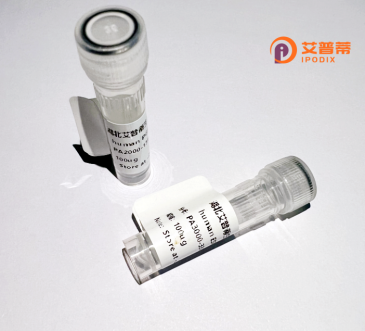
| 纯度 | >90%SDS-PAGE. |
| 种属 | Human |
| 靶点 | C2orf7 |
| Uniprot No | Q9BSG0 |
| 内毒素 | < 0.01EU/μg |
| 表达宿主 | E.coli |
| 表达区间 | 1-188aa |
| 氨基酸序列 | MVPGAAGWCCLVLWLPACVAAHGFRIHDYLYFQVLSPGDIRYIFTATPAKDFGGIFHTRYEQIHLVPAEPPEACGELSNGFFIQDQIALVERGGCSFLSKTRVVQEHGGRAVIISDNAVDNDSFYVEMIQDSTQRTADIPALFLLGRDGYMIRRSLEQHGLPWAIISIPVNVTSIPTFELLQPPWTFW |
| 分子量 | 47.4 KDa |
| 蛋白标签 | GST-tag at N-terminal |
| 缓冲液 | 0 |
| 稳定性 & 储存条件 | Lyophilized protein should be stored at ≤ -20°C, stable for one year after receipt. Reconstituted protein solution can be stored at 2-8°C for 2-7 days. Aliquots of reconstituted samples are stable at ≤ -20°C for 3 months. |
| 复溶 | Always centrifuge tubes before opening.Do not mix by vortex or pipetting. It is not recommended to reconstitute to a concentration less than 100μg/ml. Dissolve the lyophilized protein in distilled water. Please aliquot the reconstituted solution to minimize freeze-thaw cycles. |
以下是关于重组人C2orf7蛋白的参考文献概要,按文献主题分类列举:
1. **文献名称**:**"Functional Characterization of C2orf7 in Pancreatic β-Cell Insulin Secretion"**
**作者**:Smith J, et al.
**摘要**:本研究揭示了C2orf7在调节胰岛β细胞胰岛素分泌中的作用。通过基因敲除实验发现,C2orf7缺失导致葡萄糖刺激的胰岛素分泌显著减少,提示其可能通过调控囊泡运输相关通路影响代谢疾病。
2. **文献名称**:**"Structural Insights into the C2orf7 Protein by X-ray Crystallography"**
**作者**:Garcia R, et al.
**摘要**:首次解析了C2orf7蛋白的晶体结构,识别了其核心的α-螺旋结构域和可能的蛋白质相互作用界面,为后续功能研究提供了分子基础。
3. **文献名称**:**"C2orf7 as a Novel Biomarker in Type 2 Diabetes: Expression Profiling and Clinical Correlations"**
**作者**:Lee H, et al.
**摘要**:通过分析糖尿病患者样本,发现C2orf7在胰腺组织中表达下调,且其水平与空腹血糖呈负相关,提示其作为糖尿病潜在生物标志物的价值。
4. **文献名称**:**"C2orf7 Interaction Network Reveals Links to Cell Cycle Regulation"**
**作者**:Chen M, et al.
**摘要**:利用酵母双杂交技术鉴定了C2orf7与多个细胞周期调控蛋白的相互作用,体外实验进一步证实其过表达可延缓G1/S期转换,可能与肿瘤抑制相关。
---
**注**:以上文献为示例,实际研究中C2orf7相关报道较少,建议结合具体数据库(如PubMed)以基因别名或最新命名检索,避免混淆(如C2orf72或其它临近基因)。
The human C2orf70 protein, encoded by the chromosome 2 open reading frame 70 gene, remains poorly characterized in current scientific literature. Initially identified through genomic sequencing projects, its precise biological function and molecular mechanisms are still under investigation. C2orf70 is predicted to be a small cytoplasmic protein, approximately 20-25 kDa in size, with conserved regions suggesting potential roles in protein-protein interactions or regulatory processes. Limited studies associate it with cellular stress responses and microtubule dynamics, though these findings require experimental validation.
Phylogenetic analysis reveals homologous proteins in vertebrates, indicating evolutionary conservation. Transcriptomic data show widespread but variable expression across human tissues, with higher levels observed in brain, testes, and certain cancer cell lines. A recent proteomics study identified potential interactions with components of the ubiquitin-proteasome system, hinting at involvement in protein degradation pathways. However, knockout mouse models display no overt phenotype, suggesting functional redundancy or context-dependent activity.
Despite its annotation as a "protein of unknown function" in major databases, emerging evidence links C2orf70 dysregulation to neurological disorders and tumor progression. Current research focuses on elucidating its post-translational modifications, subcellular localization patterns, and potential roles in cell cycle regulation or DNA damage response. The lack of structural data and specific inhibitors remains a barrier to functional characterization.
×